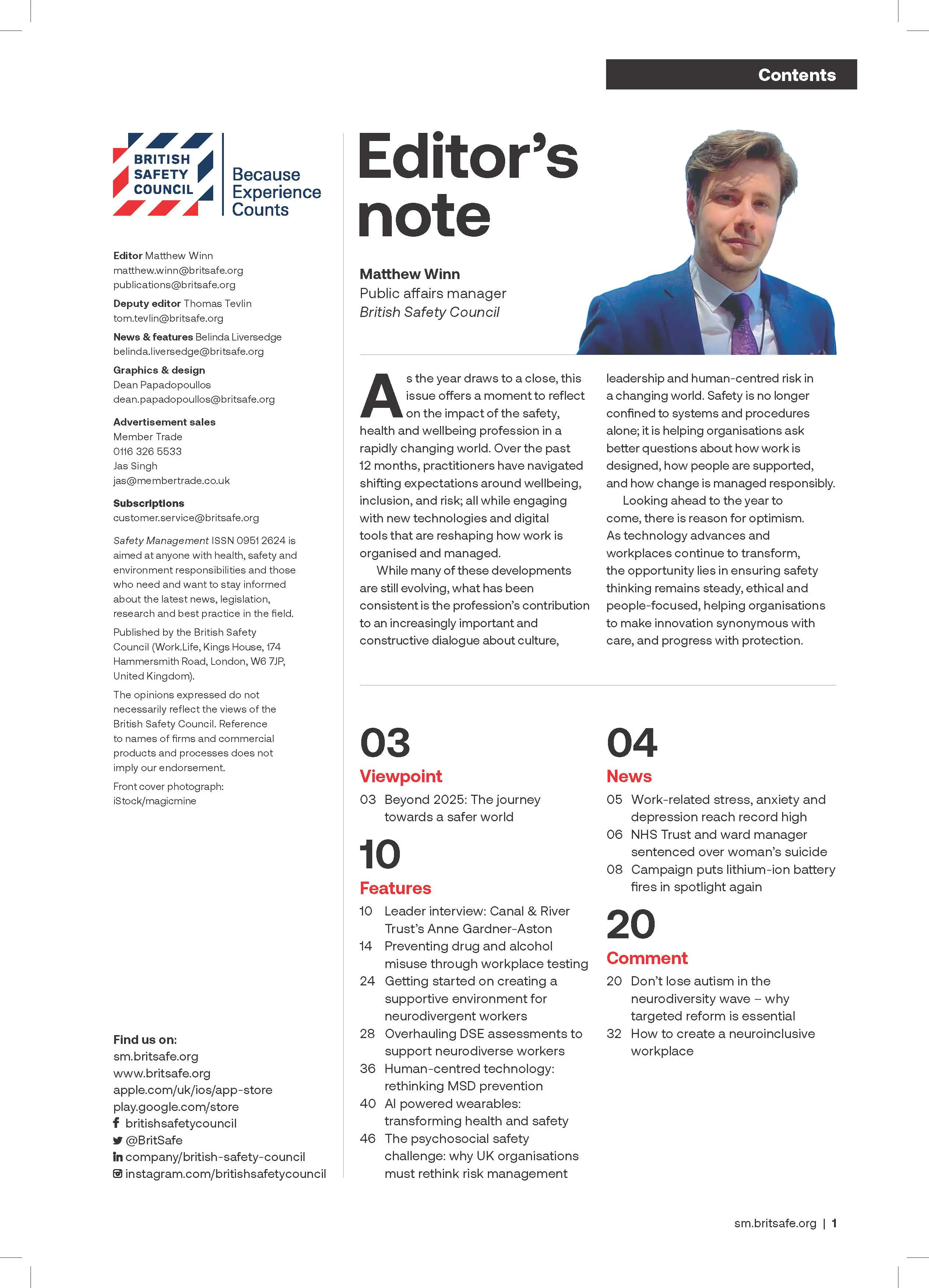Upon its introduction half a century ago, the Health and Safety at Work Act 1974 ushered in a new regulatory system, philosophy and regulator for managing occupational safety and health (OSH) risks in Britain. To mark this landmark anniversary, four former senior Health and Safety Executive staff have published a book exploring how the system which underpins Britain’s OSH performance has survived for so long and weathered various challenges along the way.
Features
Celebrating 50 years of The Health and Safety at Work Act 1974
Fifty years ago – on 1 April 1975 – key sections (in particular sections 2–9) of the Health and Safety at Work Act 1974 (HSWA) came into force. This was the final building block of a fundamental change in philosophy and approach to managing OSH risks in Great Britain (GB). The change derived from the seminal Robens report published in July 1972.
The Act itself received its Royal Assent on 31 July 1974. Two bodies created to administer and regulate its provisions were created on 1 October 1974 (the Health and Safety Commission) and 1 January 1975 (the Health and Safety Executive, HSE).
The ‘system’ developed post-Robens and its underlying design philosophy remain the cornerstone of GB’s OSH system and is widely (but not universally) admired. The philosophy and legislation have been copied in several other countries and influenced policy approaches in many more.
Given the ever-increasing pace of change in all aspects of society it is remarkable to note that the Act, the underpinning philosophy and the regulator created to administer the new approach all remain largely in place. When four of us made contact over Zoom during Covid lockdown to discuss how we might mark this series of important anniversaries, we agreed that answering whether this was actually the case and why that might be, would be an important element of what we would wish to explore. Back then we had a vague plan to write a series of essays. This evolved into self-publishing a book – Celebrating 50 years of The Health and Safety at Work Act 1974 – which is available at: amzn.eu/d/dFyuhTN.
 The book describes some of the many events over the fifty years since 1974, with chapters on leadership, major hazards, work and health, construction, public safety, and the politics of OSH.
The book describes some of the many events over the fifty years since 1974, with chapters on leadership, major hazards, work and health, construction, public safety, and the politics of OSH.
We had all spent our working lives in HSE and while we wanted to examine the 50-year history from a perspective of people ‘in the room’ for much of that time, we did not want to write a history of the organisation or a ‘kiss and tell’ account of our experiences for two reasons. First, we agreed that an exclusively HSE perspective would look self-serving and limit possible wider interest. But, more importantly, we wanted to describe events and explore how the system which delivers GB OSH performance as proposed by Robens – not just HSE’s part within it – has survived for 50 years and weathered (or not) the varied challenges along the way.
Plan A was to trawl our memories, speak to ex-colleagues, write it all down and publish. In practice we became immersed in an enjoyable and revealing trawl through the detail and the breadth of relevant material and the opportunity it provided to reflect on issues in a way that is not always possible in the ‘thick of it’. While traditional and emerging hazards dominated the foreground, there was a constant background of government reviews on specific topics (for example, occupational health, the culture of the construction industry) and on matters relating to regulatory design (de-regulatory initiatives and ‘elf ‘n’ safety’ stories for instance) and the role and purpose of regulatory bodies.
For much of the period the UK was a member of the European Union which brought different elements to the mix. OSH can be a benign or an incendiary political issue and we took to heart a comment that “nothing annoys a certain type of Briton more than the government standing between him and a painful death”.
Important elements of social history
We did rely on former colleagues for insights and peer review but the project took on a much bigger purpose as we realised that both Robens and the HSWA were important elements of social history, the impacts of which should be properly chronicled both for their own sake and to gather intelligence to inform future activity. It became clear over time that we were providing a useful archive of source material.
Our initial plan was to maintain a ‘spine’ of key dates, events, changes in government, statistics etc supplemented by a set of branches containing more personal reflections. This proved elusive because we realised soon after starting that it is difficult to untangle 50 years of events and experiences. OSH, like life, is not neat and tidy. We instead have written thematic accounts to illustrate the variety of elements which shaped the development of the OSH system.
 L-R, the authors, David Ashton, Kevin Myers, David Eves and David Snowball.
L-R, the authors, David Ashton, Kevin Myers, David Eves and David Snowball.
We began with what Robens actually said – not least because 50 years is a long time ago and many (most?) people today involved in delivering the OSH system were probably not born by 1972. To our surprise, it appeared that nobody had previously attempted to mark his homework (or rather the homework of those charged with implementing his report). We published a complementary book in 2024 explaining why Robens was appointed to carry out the work, gave an assessment of what subsequently happened with his recommendations and provided a statistical analysis of the OSH performance in GB in the intervening years.
Huge task
The task facing the Robens committee was huge. There were over 1,000 annual fatalities at work (and these figures excluded the self-employed, who were largely outside the regulatory regimes), non-fatal injuries were widespread and regulation was divided among multiple government departments and inspectorates.
The committee’s diagnosis was withering. It concluded that Britain’s health and safety system was failing not for lack of rules, but because it relied on too much prescriptive law of the wrong kind which itself generated apathy. They proposed a radical new approach:
- A simpler, goalsetting, outcome-based, regulatory framework
- The principle that the person who creates risk should be responsible for its management and control…
- ….in consultation with those exposed to risk
- A regulatory system that places more emphasis on ‘self-regulation’ and fosters tripartite engagement between government, employers, and workers
- Creation of a new regulator to establish and promote this framework, but also to hold to account those who do not deliver.
This blueprint led directly to the Health and Safety at Work Act 1974, passed with rare bipartisan support during a turbulent political period.
The book considers how this approach grew and evolved over the years with chapters that are:
- Cross cutting – such as how the new OSH system developed (“From apathy to engagement”) and how the work and approach of regulators evolved
- Topics – leadership, work and health, public protection, and
- Particular sectors – major hazards and construction.
Lazy trope
Two further chapters cover OSH and Europe and The Politics of OSH. We challenge the lazy trope that all legislation emerging from Europe was forced on GB by setting out how much of the influence flowed in the opposite direction. We deconstruct and analyse the interface between the (big) Political and (little) political implications for the OSH system – both specifically and in the context of wider debate on the role of regulation and quangos. Although the book’s central focus is OSH, the 50 years of history includes learning that would be equally relevant to other contemporary policy areas, including how to:
- Build bipartisan consensus in difficult policy areas which require long-term solutions
- Develop policy that is evidence-based and relevant in the real world
- Devise relevant risk-based and proportionate regulatory models.
We explain why the HSWA has survived so long, and why we think the system it created remains fit for purpose because it has in-built characteristics such as flexibility, adaptability, proportionality and risk ownership.
That is not to suggest complacency that all OSH risks are now being effectively managed. There is still more to be done as law cannot eliminate all ignorance or wilfulness or always ensure that even well-intentioned policies or procedures remain effective without monitoring and assurance. But it is to argue that new or growing risks such as Artificial Intelligence or mental health do not necessarily need new primary or secondary law as the first port of call.
Carrying out this work has highlighted or confirmed several issues for us.
First, the range and diversity of OSH issues and incidents that have arisen over the 50 years starting with the Flixborough explosion in 1974, just as the new Act was being readied. Other significant events include Piper Alpha, Buncefield and more recently the Grenfell Tower tragedy and the Covid pandemic. In an almost bewildering variety of issues, we refer to the Heathrow Tunnel collapse, several outbreaks of Legionnaires’ disease, a smallpox death caused by unsafe procedures in a university laboratory, train crashes, gas explosions and deaths from dangerous leisure activities and falling trees. Many of these would not have been on the Robens radar.
On the positive side, we also give many examples of things being done right, in the way Robens would have commended, and of harm being prevented. The completion of the building work for the London Olympics with no fatalities – still a unique achievement – is an excellent example, particularly as the process was methodically captured for future learning.
Numerous reviews
Second, the sheer volume and frequency of reviews of the OSH system over the years. For example, a departing Director General of HSE wrote in his 1994 Christmas message to staff that in the previous three years alone HSE had faced seven major external or part-external reviews, two of which began by asking whether the organisation should exist at all. 2010 to 2014 saw a similar intense period of scrutiny.
We would not challenge the right (and responsibility) of governments to seek assurance of the effectiveness and operation of systems they administer. But such reviews tend to be more informative (and resource efficient) if they are evidence rather than policy driven. A basic reason for the system’s survival was, quite simply, that key stakeholders from all sides of industry and commerce consistently spoke in its favour.
Third, the number of recent government-led initiatives looking to address the increase in ill-health problems, both physical and mental, removing people from the workforce. Incoming governments can be seen to have accepted that this poses an existential threat to economic wellbeing.
But each began afresh, with no serious attempt that we could discover to learn from previous work, or to recognise the need for a genuine joined-up approach across government as these issues do not fall neatly into work/not work silos. Much time has been lost and the problems have got worse. Reviewing is not doing. However much of a hurry governments are in, this is an issue that cries out for an evidence-led, cross party and cross government department approach, that recognises that learning from the past is also valuable. Robens did that thoroughly, and partly as a result was able to win bipartisan support for the radical new approach still in place today.
Robens did not use the term “leadership” but as we wrote the book we were constantly reminded that it is an essential prerequisite, not just for proper control of health and safety risks, but to business survival. We concluded that whatever the other demands and pressures on the people concerned, effective leadership must include using what Barry Whittingham* has called a “moral compass” to guide their organisations in a positive and lawful direction, making sure they behave in an ethically proper way – that good behaviour is good business.
The role of the regulator has evolved over the half-century. In the early days it was referred to as the “prime mover”. We argue that it is nowadays more of a catalyst and that would be consistent with Robens’ design philosophy in that more risk creators have accepted their responsibilities. However, we do question whether HSE is now sufficiently resourced to catalyse the system.
Future possibilities
We did not set out to write a manifesto but in the final chapter we offer some closing thoughts and an assessment of future possibilities and prospects for OSH oversight.
Although the book looks back over 50 years of history, many of the issues we consider are relevant to contemporary, live policy challenges. Indeed, we delayed the book’s publication to take account of recent developments – such as the Government’s response to the Grenfell Tower Public Inquiry and its various (confusing) announcements concerning the role and review of quangos and regulators.
The primary purpose or value from reviewing history is to better understand the present. We set out to write this book because we think it is important to acknowledge how we reached the current OSH position and to use insights from past experience to inform decisions about managing OSH risks in a future, changing world of work. HSWA was a significant legislative achievement and helped create a more dynamic system than existed previously.
When we were deciding on a title we felt that “Celebrating” was a justified term to use. We hope and believe that readers of our book will agree with us – or will generate an evidence-based debate with those who do not.
Any profits from sales of these two books will be donated to two charities – The King’s Trust and Mates in Mind.
Celebrating 50 years of The Health and Safety at Work Act 1974 is available to purchase at: https://amzn.eu/d/dFyuhTN
About the authors
The four authors held a variety of Director level operational and policy posts in HSE, up to and including Deputy Chief and Acting Chief Executive.
References
* Preventing Corporate Accidents – An ethical approach. R. B. Whittingham, 2008, Butterworth-Heinemann. ISBN 978-7506-8062-2.
FEATURES

Underpinning safety training with neuroscience for long lasting impact
By SSE Active Training Team (ATT) on 30 November 2025
A behavioural safety training programme developed by Active Training Team for energy provider SSE has been carefully designed with neuroscientific principles in mind – resulting in a prestigious industry award for Best Training Initiative in 2024.

Why a painted line will never be enough
By UK Material Handling Association (UKMHA) on 20 November 2025
Businesses that operate material handling equipment like forklifts are being urged to submit accident and near miss details to a new confidential reporting portal so the industry can identify what needs to be done to improve safety standards.

Why workplace transport training is changing in 2026 and what it means for employers
By AITT on 26 November 2025
New workplace transport training categories due in January mean it is essential to ensure operators of material handling equipment have the necessary training for the exact type of machine they use, and accredited training providers are an ideal source of advice and conversion training.



